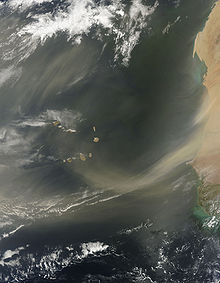
Back غبار معدني Arabic Pols mineral Catalan Polvo mineral Spanish אבק מינרלי HE Минерална прашина Serbian

| Granulometry | |
|---|---|
 | |
| Basic concepts | |
| Particle size, Grain size, Size distribution, Morphology | |
| Methods and techniques | |
| Mesh scale, Optical granulometry, Sieve analysis, Soil gradation | |
Related concepts | |
| Granulation, Granular material, Mineral dust, Pattern recognition, Dynamic light scattering | |
Mineral dust is atmospheric aerosol originated from the suspension of minerals constituting the soil, composed of various oxides and carbonates. Human activities lead to 30% of the airborne dust (particulates) load in the atmosphere. The Sahara Desert is the major source of mineral dust, which subsequently spreads across the Mediterranean (where it is the origin of rain dust) and Caribbean seas into northern South America, Central America, and eastern North America, and Europe. Additionally, it plays a significant role in the nutrient inflow to the Amazon rainforest.[1] The Gobi Desert is another source of dust in the atmosphere, which affects eastern Asia and western North America.
- ^ Koren, I.; Kaufman, Y. J.; Washington, R.; Todd, M. C.; Rudich, Y.; Martins, J. V.; Rosenfeld, D. (2006). "The Bodélé depression: a single spot in the Sahara that provides most of the mineral dust to the Amazon forest". Environmental Research Letters. 1 (1): 014005. Bibcode:2006ERL.....1a4005K. doi:10.1088/1748-9326/1/1/014005.
© MMXXIII Rich X Search. We shall prevail. All rights reserved. Rich X Search